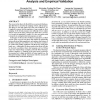971 search results - page 126 / 195 » Automatic prediction of frustration |
GECCO
2008
Springer
13 years 10 months ago
2008
Springer
The crossover bias theory for bloat [18] is a recent result which predicts that bloat is caused by the sampling of short, unfit programs. This theory is clear and simple, but it ...
BMCBI
2007
13 years 9 months ago
2007
Background: Incorrectly annotated sequence data are becoming more commonplace as databases increasingly rely on automated techniques for annotation. Hence, there is an urgent need...
BMCBI
2006
13 years 9 months ago
2006
Background: Identifying functional elements, such as transcriptional factor binding sites, is a fundamental step in reconstructing gene regulatory networks and remains a challengi...
BMCBI
2007
13 years 9 months ago
2007
Background: Protein remote homology detection is a central problem in computational biology. Most recent methods train support vector machines to discriminate between related and ...
CGF
2004
13 years 9 months ago
2004
Despite the notable progress in physically-based rendering, there is still a long way to go before we can automatically generate predictable images of biological materials. In thi...

